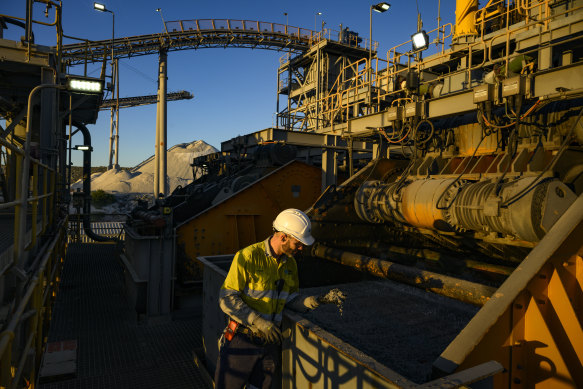- Exclusive
- Politics
- Federal
- Manufacturing
This was published 8 months ago
Super funds keen to invest in Australian-made scheme as gas fight flares
By Mike Foley
Giant superannuation funds have declared they are eager to start spending on local projects under the Albanese government’s $22.7 billion Australian manufacturing scheme, but the Greens have set up a political clash with threats to derail the key policy over public funding for fossil fuels.
A parliamentary inquiry into the government’s draft laws to establish the Future Made in Australia scheme is set to report early next month and the Greens’ support is crucial after the opposition declared it will not support the fund, deriding it as “billions for billionaires”.

The $22.7 billion Future Made in Australia fund is being developed to support local industries like lithium processing.Credit: The New York Times
But institutional investors with hundreds of billions of dollars under management have for the first time backed the scheme, stating that public financing can unlock the private capital needed to grow green industries to slash emissions, boost jobs and hit the nation’s climate targets.
“Unlocking investment at-scale into Australia’s energy transition can only happen if industry and government work together to achieve the right policy settings,” said David Whiteley, head of external relations for global infrastructure investment fund IFM Investors, with $218 billion under management.
“Initiatives like Future Made in Australia help Australia compete for its fair share of global capital increasingly looking to invest in the transition,” said Jeff Brunton, head of portfolio management at HESTA, which has around $85 billion in funds under management.
Rest, and climate change investment and advisory firm Pollination, also endorsed the Future Made in Australia.
The scheme would provide subsidies and seed capital for materials needed for the green transition - like processing critical minerals such as lithium and rare earths used in batteries, or green steel and hydrogen fuel, as well as local manufacture of solar panels and batteries.
It is the government’s response to international competition for global green investment.
Analysts have said the US Inflation Reduction Act could deliver up to $1.56 trillion in production credits for green products such as solar technology, and the European Union, Korea and Japan have also announced similarly ambitious schemes.
“This is Australia in the new global competition fighting for good skilled jobs in regions and outer suburbs,” said Assistant Trade Minister Tim Ayres, who is responsible for Future Made in Australia.
Greens leader Adam Bandt will wait for the inquiry report until he finalises his position on the fund, but he declared that to win his support, the government must not fund projects that use fossil fuels.
“With Labor now backing coal and gas past 2050, this could be another coal and gas slush fund, with no guardrails to stop them tipping even more public money into fossil fuels,” Bandt said.
“The Greens will continue to consider this bill, but we want to ensure everyone benefits from the mining boom 2.0, not just profit gouging big corporations, and that Labor stops opening new coal and gas mines.”
Ayres said some projects backed by the scheme may need gas, which is used in manufacturing as both a fuel and a feedstock, as they make the switch to cleaner technology that is not yet in commercial production.
“It’s the goldilocks amount [of gas], just the right amount, that is required to support manufacturers as they transition to electrifying their production processes,” he said.
But many economists are wary of the scheme and its potential to squander taxpayers’ money.
Independent economist Saul Eslake said the government risked wasting taxpayers’ money on projects that would likely fail due to inherent challenges for local manufacturers.
“Australia’s problem is that we neither have a big domestic market nor are geographically proximate to any big domestic markets,” he said.
“[The scheme] reeks of what I’ve long called manufacturing fetishism, the belief that there is something inherently more noble about manufacturing than other types of economic activity,” Eslake said.
He warned that using public investment to lure in private capital could suck resources away from more profitable industries like mining, agriculture and services.
However, Eslake stressed he supported government spending to drive the switch in the energy grid from fossil fuels to renewables.
Grattan Institute energy director Tony Wood said it was crucial that guardrails were put in place to force the responsible minister to act on advice from his department and experts.
“When government is picking winners you don’t want the losers picking governments - what I mean by that is when vested interests come out in strength.”
There are bright opportunities for the Future Made in Australia funds, Wood said, but rather than making batteries or solar panels the government should back green minerals processing.
Wood said Australia’s vast landmass and abundant supply of wind and solar energy could be harnessed to power energy-hungry processing of commodities with strong demand through the green transition like iron ore, bauxite copper, nickel, lithium, cobalt and other critical minerals.